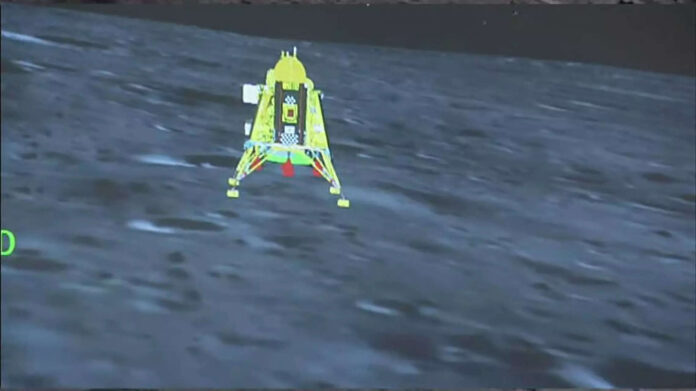By taking this giant step for mankind, India joins the elite club of space technology giants, the fourth in the world, which include the Soviet Union / Russia, the United States, and China.
Bengaluru: India has scripted a new chapter in space exploration history and has become the first country ever to land a spacecraft on the far more difficult and rugged terrain of the moon’s southern polar region, a special report by Shubhadeep Choudhury in The Tribune, Chandigarh says.
By taking this giant step for mankind, India joins the elite club of space technology giants, the fourth in the world, which include the Soviet Union / Russia, the United States and China.
India’s brilliant success has won praise and plaudits from every corner of the world, and comes only a week after a Russian spacecraft, Luna-25, crash-landed on the lunar surface in an unsuccessful attempt.
As he watched the live streaming of this momentous event from South Africa, in the midst of the BRICS summit – a group that includes Brazil, Russia, India, China and South Africa – in Johannesburg, Prime Minister Narendra Modi, waved the Indian flag and said: “This success belongs to all of humanity” .
He added “This moment is unforgettable. It is phenomenal. This is a victory cry of a new India,”
“All the people of the world, the people of every country and region: India’s successful moon mission is not just India’s alone … this success belongs to all of humanity,” Modi said,
“We can all aspire for the moon, and beyond,” he added.
Russian President Vladimir Putin congratulated India in a message to Modi published on the Kremlin website.
“This is a big step forward in space exploration and of course a testament to the impressive progress made by India in the field of science and technology,” he said.
NASA Administrator Bill Nelson congratulated the ISRO on the landing.
“And congratulations to India on being the 4th country to successfully soft-land a spacecraft on the Moon,” he said on X, formerly Twitter. “We’re glad to be your partner on this mission!”
Closer home in India, scientists and officials clapped, cheered and hugged each other as the spacecraft landed and people across India broke out in celebration, setting off firecrackers and dancing in the streets.
People across the country were glued to television screens and said prayers as the spacecraft approached the surface. Nearly 7 million watched the YouTube live stream.
“India is on the moon,” said S. Somanath, chief of the Indian Space Research Organisation (ISRO) as the Chandrayaan-3 landed, making India the fourth nation to successfully land a spacecraft on the moon after the Soviet Union./ Russia, the United States and China.
He told reporters, the landing has given India confidence to extend its reach to possible voyages to Mars and Venus.
India is also planning to launch a mission in September to study the sun, Somanath said. A human space flight is also planned and, while no official date has been announced, preparations are likely to be ready by 2024.
Jayant Murthy, senior professor at the Bengaluru-based Indian Institute of Astrophysics, while talking to The Tribune said “Presence of water in the lunar south pole is confirmed. Chandrayaan-3 may shed light on the volume and extent of water that can be found on the moon. This can open up a whole range of possibilities,” today.
India has also done more with less than its top global counterparts, with ISRO’s annual budget a fraction of NASA’s. In 2020, ISRO estimated the Chandrayaan-3 mission would cost about $75 million.
The Chandrayaan mission launched in 2013 cost Rs 470 crore whereas the George Clooney-starrer Hollywood movie budget was Rs 644 crore ($100 million). This surely showcases the cost-effectiveness of ISRO’s space missions.
The lunar south pole has emerged as a place of exploration interest thanks to recent discoveries of traces of water ice on the moon.
India had previously attempted a lunar south pole landing in September 2019, but a software failure caused the Chandrayaan-2 mission to crash into the surface.
″[The south pole is] really a very interesting, historical, scientific and geologic area that a lot of countries are trying to get at that can serve as a base for future exploration,” Wendy Whitman Cobb, professor of strategy and security studies at the U.S. Air Force School of Advanced Air and Space Studies, told CNBC.
Whitman Cobb added that the discovery of water on the south pole of the moon is “really important for future exploration,” as it could serve as a source of fuel for rockets and spacecraft.
Chandrayaan means “moon vehicle” in Hindi and Sanskrit. In 2019, ISRO’s Chandrayaan-2 mission successfully deployed an orbiter but its lander crashed.
Days before Chandrayaan-3′s landing, Russia attempted to land its first spacecraft on the moon in almost 50 years. But the Luna-25 mission smashed into the lunar surface on Saturday, with Russian space agency Roscosmos confirming the spacecraft spun of control.
Earlier this year, the first attempted landing by Japanese company Ispace also crashed in the final moments.



